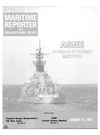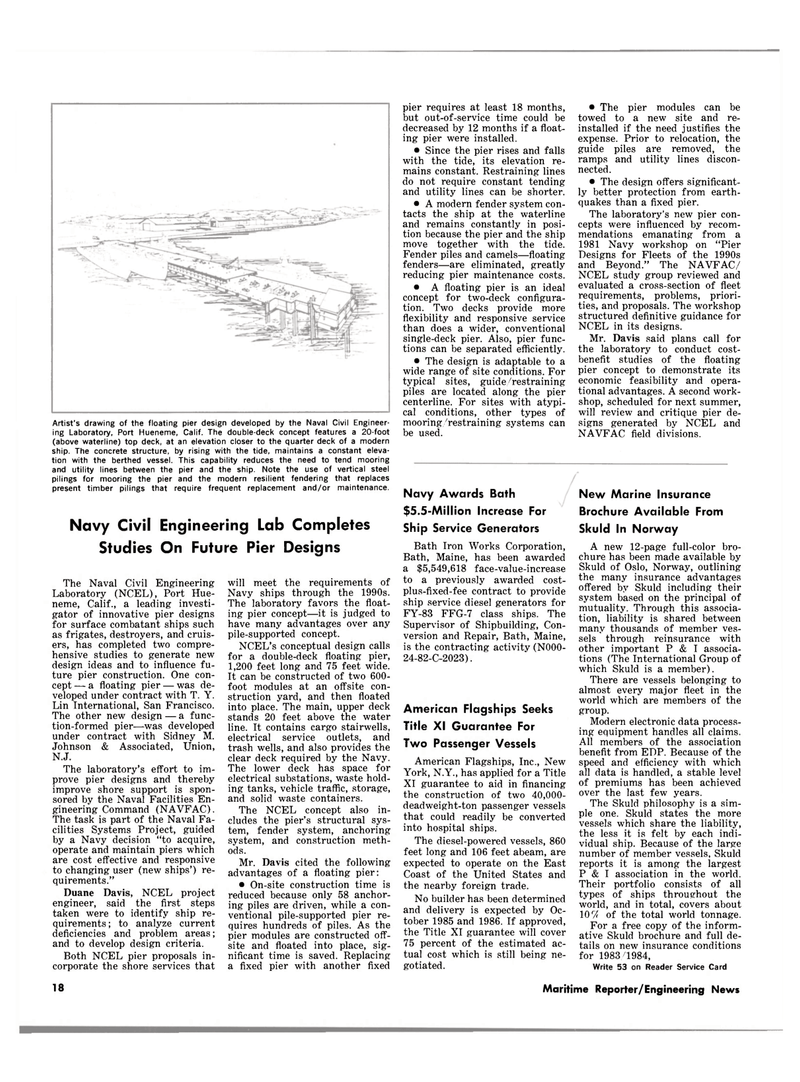
Page 16: of Maritime Reporter Magazine (January 15, 1983)
Read this page in Pdf, Flash or Html5 edition of January 15, 1983 Maritime Reporter Magazine
Artist's drawing of the floating pier design developed by the Naval Civil Engineer- ing Laboratory, Port Hueneme, Calif. The double-deck concept features a 20-foot (above waterline) top deck, at an elevation closer to the quarter deck of a modern ship. The concrete structure, by rising with the tide, maintains a constant eleva- tion with the berthed vessel. This capability reduces the need to tend mooring and utility lines between the pier and the ship. Note the use of vertical steel pilings for mooring the pier and the modern resilient tendering that replaces present timber pilings that require frequent replacement and/or maintenance.
Navy Civil Engineering Lab Completes
Studies On Future Pier Designs
The Naval Civil Engineering
Laboratory (NCEL), Port Hue- neme, Calif., a leading investi- gator of innovative pier designs for surface combatant ships such as frigates, destroyers, and cruis- ers, has completed two compre- hensive studies to generate new design ideas and to influence fu- ture pier construction. One con- cept — a floating pier — was de- veloped under contract with T. Y.
Lin International, San Francisco.
The other new design — a func- tion-formed pier—was developed under contract with Sidney M.
Johnson & Associated, Union,
N.J.
The laboratory's effort to im- prove pier designs and thereby improve shore support is spon- sored by the Naval Facilities En- gineering Command (NAVFAC).
The task is part of the Naval Fa- cilities Systems Project, guided by a Navy decision "to acquire, operate and maintain piers which are cost effective and responsive to changing user (new ships') re- quirements."
Duane Davis, NCEL project engineer, said the first steps taken were to identify ship re- quirements; to analyze current deficiencies and problem areas; and to develop design criteria.
Both NCEL pier proposals in- corporate the shore services that pier requires at least 18 months, but out-of-service time could be decreased by 12 months if a float- ing pier were installed. • Since the pier rises and falls with the tide, its elevation re- mains constant. Restraining lines do not require constant tending and utility lines can be shorter. • A modern fender system con- tacts the ship at the waterline and remains constantly in posi- tion because the pier and the ship move together with the tide.
Fender piles and camels—floating fenders—are eliminated, greatly reducing pier maintenance costs. • A floating pier is an ideal concept for two-deck configura- tion. Two decks provide more flexibility and responsive service than does a wider, conventional single-deck pier. Also, pier func- tions can be separated efficiently. • The design is adaptable to a wide range of site conditions. For typical sites, guide/restraining piles are located along the pier centerline. For sites with atypi- cal conditions, other types of mooring/restraining systems can be used. • The pier modules can be towed to a new site and re- installed if the need justifies the expense. Prior to relocation, the guide piles are removed, the ramps and utility lines discon- nected. • The design offers significant- ly better protection from earth- quakes than a fixed pier.
The laboratory's new pier con- cepts were influenced by recom- mendations emanating from a 1981 Navy workshop on "Pier
Designs for Fleets of the 1990s and Beyond." The NAVFAC/
NCEL study group reviewed and evaluated a cross-section of fleet requirements, problems, priori- ties, and proposals. The workshop structured definitive guidance for
NCEL in its designs.
Mr. Davis said plans call for the laboratory to conduct cost- benefit studies of the floating pier concept to demonstrate its economic feasibility and opera- tional advantages. A second work- shop, scheduled for next summer, will review and critique pier de- signs generated by NCEL and
NAVFAC field divisions. will meet the requirements of
Navy ships through the 1990s.
The laboratory favors the float- ing pier concept—it is judged to have many advantages over any pile-supported concept.
NCEL's conceptual design calls for a double-deck floating pier, 1,200 feet long and 75 feet wide.
It can be constructed of two 600- foot modules at an offsite con- struction yard, and then floated into place. The main, upper deck stands 20 feet above the water line. It contains cargo stairwells, electrical service outlets, and trash wells, and also provides the clear deck required by the Navy.
The lower deck has space for electrical substations, waste hold- ing tanks, vehicle traffic, storage, and solid waste containers.
The NCEL concept also in- cludes the pier's structural sys- tem, fender system, anchoring system, and construction meth- ods.
Mr. Davis cited the following advantages of a floating pier: • On-site construction time is reduced because only 58 anchor- ing piles are driven, while a con- ventional pile-supported pier re- quires hundreds of piles. As the pier modules are constructed off- site and floated into place, sig- nificant time is saved. Replacing a fixed pier with another fixed
Navy Awards Bath $5.5-Million Increase For
Ship Service Generators
Bath Iron Works Corporation,
Bath, Maine, has been awarded a $5,549,618 face-value-increase to a previously awarded cost- plus-fixed-fee contract to provide ship service diesel generators for
FY-83 FFG-7 class ships. The
Supervisor of Shipbuilding, Con- version and Repair, Bath, Maine, is the contracting activity (N000- 24-82-C-2023).
American Flagships Seeks
Title XI Guarantee For
Two Passenger Vessels
American Flagships, Inc., New
York, N.Y., has applied for a Title
XI guarantee to aid in financing the construction of two 40,000- deadweight-ton passenger vessels that could readily be converted into hospital ships.
The diesel-powered vessels, 860 feet long and 106 feet abeam, are expected to operate on the East
Coast of the United States and the nearby foreign trade.
No builder has been determined and delivery is expected by Oc- tober 1985 and 1986. If approved, the Title XI guarantee will cover 75 percent of the estimated ac- tual cost which is still being ne- gotiated.
New Marine Insurance
Brochure Available From
Skuld In Norway
A new 12-page full-color bro- chure has been made available by
Skuld of Oslo, Norway, outlining the many insurance advantages offered by Skuld including their system based on the principal of mutuality. Through this associa- tion, liability is shared between many thousands of member ves- sels through reinsurance with other important P & I associa- tions (The International Group of which Skuld is a member).
There are vessels belonging to almost every major fleet in the world which are members of the group.
Modern electronic data process- ing equipment handles all claims.
All members of the association benefit from EDP. Because of the speed and efficiency with which all data is handled, a stable level of premiums has been achieved over the last few years.
The Skuld philosophy is a sim- ple one. Skuld states the more vessels which share the liability, the less it is felt by each indi- vidual ship. Because of the large number of member vessels, Skuld reports it is among the largest
P & I association in the world.
Their portfolio consists of all types of ships throughout the world, and in total, covers about 10 r/< of the total world tonnage.
For a free copy of the inform- ative Skuld brochure and full de- tails on new insurance conditions for 1983/1984,
Write 53 on Reader Service Card 18 Maritime Reporter/Engineering News

 15
15

 17
17
